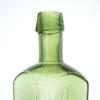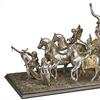Color and Light: The Neo-Impressionist Henri-Edmond Cross
- POTSDAM, Germany
- /
- August 06, 2018
Henri-Edmond Cross (1856–1910) is widely considered a leading exponent of French Neo-Impressionism. Together with his friend and colleague Paul Signac, he discovered the Côte d’Azur for painting. Situated between the Impressionists around Claude Monet and the forerunners of Expressionism around Henri Matisse, his oeuvre marks a crucial step along the path toward color as an autonomous pictorial means and, by extension, toward abstraction. In Germany, he was celebrated early on as a pioneer of modernism. In collaboration with the Musée des impressionnismes in Giverny, the Museum Barberini in Potsdam is showing the first retrospective (Nov. 17, 2018 to Feb. 17, 2019) devoted to Cross at a German museum. Alongside his prominent role within the Neo-Impressionist movement, the exhibition examines his influence on later developments within the French avant-garde, illuminating Cross’s significance as a major pioneer of 20th-century painting.
Henri-Edmond Delacroix was born Douai in northern France in 1856. His artistic formation began in 1866 with Carolus Duran, followed by lessons at the Écoles Académiques de Dessin et d’Architecture in Lille, as well as with the Parisian painters François Bonvin and Émile Dupont-Zipcy. Keen to preclude any associations with the famous painter Eugène Delacroix, he began exhibiting under the pseudonym of Cross in 1883. During the following year, he was among the founding members of the Salon des Indépendants, where he became acquainted with Paul Signac, and where he was represented prominently (with rare exceptions) until 1910. In the early 1890s, he began to experiment with the new painting technique known as Pointillism or Divisionism. Heralded by Georges Seurat, this method consisted in the juxtaposition of luminous colors applied in small, dotted brushstrokes. Cross’s early Neo-Impressionist paintings such as Bullfight (ca. 1891–92, private collection) or Hair (ca. 1892, Musée d’Orsay, Paris) may well be considered as an homage to the movement’s great originator.
Decisive for the development of Cross’s oeuvre was his move to the French Riviera, whose natural beauty became his key source of inspiration. In 1891, he took a house on the shore in Cabasson, relocating slightly later to the coastal town of Saint-Clair. Although Cross kept an eye on the metropolitan art scene and maintained contact with his fellow Néos, his style evolved under these new living and working conditions: the dark, earthy colors of his early work were supplanted by a brighter palette and striking tonal contrasts. Characteristic of Cross’s works of this time are landscapes and genre paintings which reflect a romanticized, blissful view of rural life along the coastline (cf. The Farm [Morning], 1893, Musée des Beaux-Arts, Nancy; The Farm [Evening], 1893, private collection; The Washerwoman, 1895, private collection). In his late works, he often endowed his natural idylls with allegorical or mythological overtones, ultimately reminiscent of an idealized Golden Age (cf. Joyful Bathing, 1899–1902, private collection; Faun, 1905–06, private collection). “I would like to paint happiness, the happy beings who men can be in a few centuries (?) when pure anarchy will be realized,” he wrote to Signac in June 1893, inserting a question mark after “centuries.” In a forward to Cross’s 1905 solo exhibition at the Galerie Druet in Paris, the Belgian poet Émile Verhaeren perceived his art as a “glorification of nature” as well as a “glorification of an inner vision” that he saw characterized by a “pantheistic ardor.” Such reverberations of the idea of an earthly paradise are reflected in Cross’s depictions of the light-flooded Riviera, among them Beach at Saint-Clair (1901, private collection) and A Pine Wood (1906, private collection).
At the beginning of the 20th century, Cross was regarded as one of the most important representatives of French painting, and served as a model and mentor for aspiring avant-garde artists such as Henri Matisse and Albert Marquet, who maintained lively exchanges with him. During these years, Cross’s works were also regularly exhibited at national and international shows. In Germany, his paintings were frequently shown and avidly discussed, significantly contributing to his early reputation as a key player in the development of modern art. Among his most fervent admirers was the collector Count Harry Kessler, who purchased numerous works by the artist, among them Landscape at Bormes (1907, private collection), Pardigon, Coast in Provence, Evening (1907, The Kasser Mochary Foundation, Montclair, New Jersey) and Pink Spring (1909, private collection). Even before their counterparts in France, German museum founders and directors such as Karl Ernst Osthaus and Georg Swarzenski purchase works by Cross, among them the large-format canvas Afternoon in the Garden (1904, Städel Museum, Frankfurt am Main). The groundbreaking exhibition at the Sonderbund in Cologne in 1912 celebrated Cross as a leading figure of the French avant-garde, alongside Paul Cézanne, Pablo Picasso, and Vincent van Gogh
The exhibition at the Museum Barberini is the first exhibition devoted to this artist at a German museum. Approximately 20 years after the last Cross retrospective (Musée de la Chartreuse, Douai, 1998/99), it surveys the entirety of his artistic career, presenting his innovative handling of color and light in the wider context of the avant-garde of his time. At the same time, the exhibition sheds light on Cross’s fascination with the tenets of anarchism, exploring the sociopolitical thrust of his painted utopias. “Cross’s early reception in Germany was a decisive factor in our conception of this project. Many works that were in German hands at the beginning of the 20th century, or were shown in German exhibitions, are returning in the context of this retrospective,” explains Ortrud Westheider, Director of the Museum Barberini. Daniel Zamani, curator of the exhibition in Potsdam, adds: “Many of the paintings listed in the catalogue raisonné of Cross’s works published in 1964 are either lost or in private collections. We are therefore thrilled to have won the support of so many private collectors. It is largely due to their generous support that we can present our public with a representative cross-section of Cross’s oeuvre, including many of his most ambitious Neo-Impressionist paintings.”
Overall, the retrospective includes around 100 paintings, watercolors, and drawings from all phases of the artist’s career, among them loans from the Musée d’Orsay in Paris, the Museo Nacional Thyssen-Bornemisza in Madrid, the Ny Carlsberg Glyptotek in Copenhagen, the Museum of Fine Arts in Houston, the Toledo Museum of Art in Ohio, the Chrysler Museum of Art in Norfolk, as well as numerous works from international private collections. Among the highlights of the show are two of Cross’s earliest Neo-Impressionist seascapes, Calanque des Antibois (1891–92) and Plage de la Vignasse (ca. 1891–92), which are on loan from the National Gallery of Art in Washington and the Musée d’art moderne André Malraux in Le Havre. A further highlight are Cross’s as yet largely unknown black-and-white drawings, which were executed with charcoal or Conté crayon and which attest to his intimate dialogue with Georges Seurat’s works on paper.
















